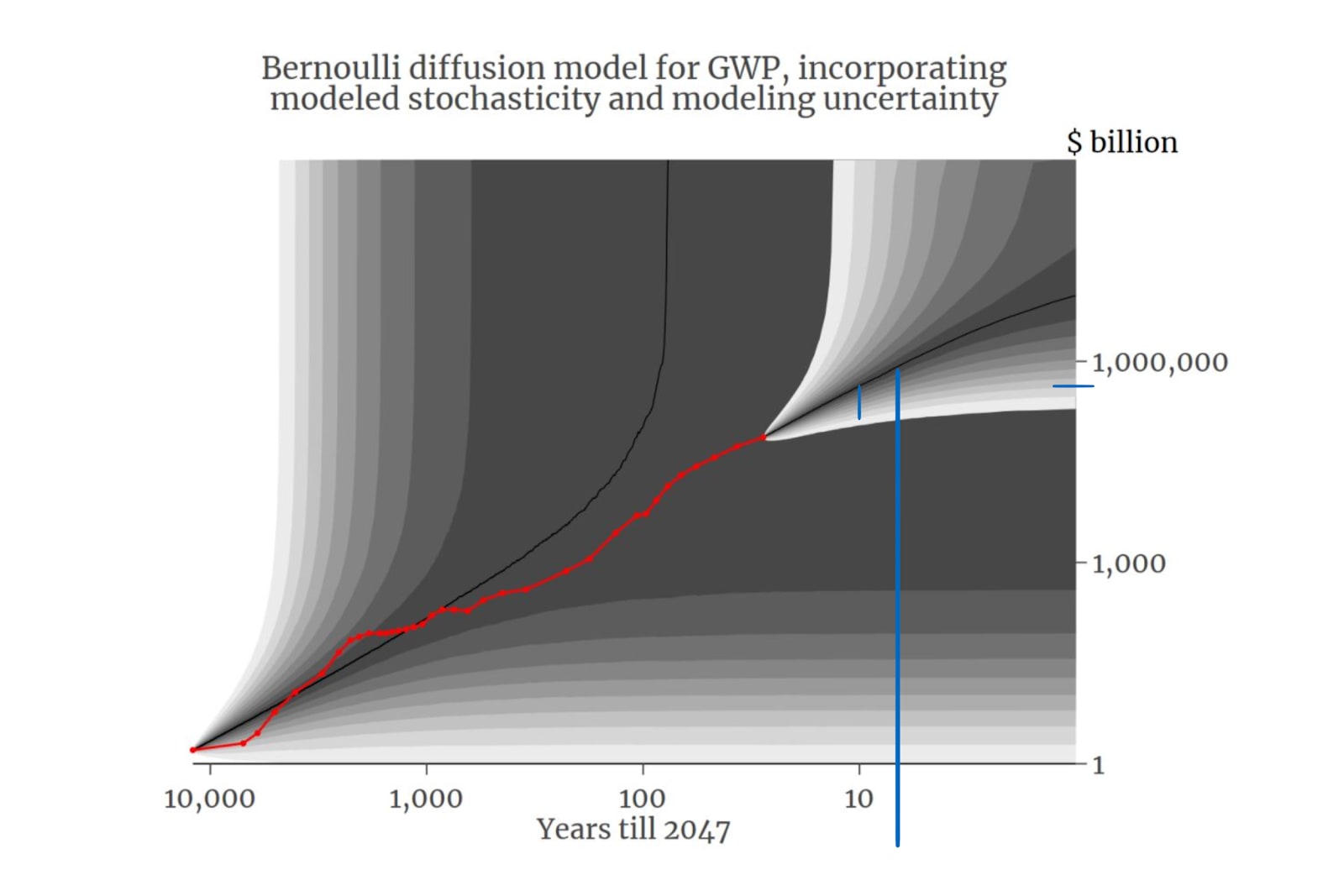How does David Roodman’s world GDP model translate to TAI timelines?
Now, before I go any further, let me be the first to say that I don’t think we should use this model to predict TAI. This model takes a very broad outside view and is thus inferior to models like Ajeya Cotra’s which make use of more relevant information. (However, it is still useful for rebutting claims that TAI is unprecedented, inconsistent with historical trends, low-prior, etc.) Nevertheless, out of curiosity I thought I’d calculate what the model implies for TAI timelines.

Here is the projection made by Roodman’s model. The red line is real historic GWP data; the splay of grey shades that continues it is the splay of possible futures calculated by the model. The median trajectory is the black line.
I messed around with a ruler to make some rough calculations, marking up the image with blue lines as I went. The big blue line indicates the point on the median trajectory where GWP is 10x what is was in 2019. Eyeballing it, it looks like it happens around 2040, give or take a year. The small vertical blue line indicates the year 2037. The small horizontal blue line indicates GWP in 2037 on the median trajectory.
Thus, it seems that between 2037 and 2040 on the median trajectory, GWP doubles. (One-ninth the distance between 1,000 and 1,000,000 is crossed, which is one-third of an order of magnitude, which is about one doubling).
This means that TAI happens around 2037 on the median trajectory according to this model, at least according to Ajeya Cotra’s definition of transformative AI as “software which causes a tenfold acceleration in the rate of growth of the world economy (assuming that it is used everywhere that it would be economically profitable to use it)... This means that if TAI is developed in year Y, the entire world economy would more than double by year Y + 4.”
What about the non-median trajectories? Each shade of grey represents 5 percent of the simulated future trajectories, so it looks like there’s about a 20% chance that GWP will be near-infinite by 2040 (and 10% by 2037). So, perhaps-too-hastily extrapolating backwards, maybe this means about a 20% chance of TAI by 2030 (and 10% by 2027).
At this point, I should mention that I disagree with this definition of TAI; I think the point of no return (which is what matters for planning) is reasonably likely to come several years before TAI-by-this-definition appears. (It could also come several years later!) For more on why I think this, see this post.
Finally, let’s discuss some of the reasons not to take this too seriously: This model has been overconfident historically. It was surprised by how fast GDP grew prior to 1970 and surprised by how slowly it grew thereafter. And if you look at the red trendline of actual GWP, it looks like the model may have been surprised in previous eras as well. Moreover, for the past few decades it has consistently predicted a median GWP-date of several decades ahead:

The grey region is the confidence interval the model predicts for when growth goes to infinity. 100 on the x-axis is 1947. So, throughout the 1900’s the model has consistently predicted growth going to infinity in the first half of the twenty-first century, but in the last few decades in particular, it’s displayed a consistent pattern of pushing back the date of expected singularity, akin to the joke about how fusion power is always twenty years away:
| Model has access to data up to year X = | Year of predicted singularity | Difference |
| 1940 | 2029 | 89 |
| 1950 | 2045 | 95 |
| 1960 | 2020 | 60 |
| 1970 | 2010 | 40 |
| 1980 | 2014 | 34 |
| 1990 | 2022 | 32 |
| 2000 | 2031 | 31 |
| 2010 | 2038 | 28 |
| 2019 | 2047 | 28 |
The upshot, I speculate, is that if we want to use this model to predict TAI, but we don’t want to take it 100% literally, we should push the median significantly back from 2037 while also increasing the variance significantly. This is because we are currently in a slower-than-the-model-predicts period, but faster-than-the-model-predicts periods are possible and indeed likely to happen around TAI. So probably the status quo will continue and GWP will continue to grow slowly and the model will continue to push back the date of expected singularity… but also at any moment there’s a chance that we’ll transition to a faster-than-the-model-predicts period, in which case TAI is imminent. EDIT: And indeed, TAI could be the thing that causes the transition to a faster-than-the-model-predicts period.
Thanks to Denis Drescher and Max Daniel for feedback on a draft. This research was conducted at the Center on Long-Term Risk and the Polaris Research Institute.